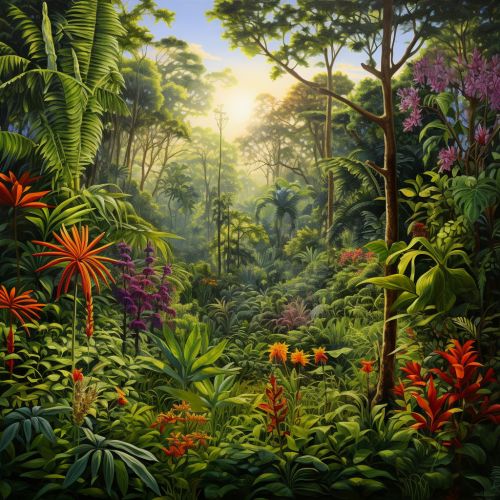Tropical Rainforest
Introduction
The Tropical Rainforest is a type of ecosystem that is characterized by its high levels of biodiversity, dense vegetation, and high annual rainfall. These forests are typically located near the equator, where the climate is warm and humid throughout the year. Tropical rainforests play a crucial role in the global ecosystem, contributing significantly to carbon sequestration and providing habitats for a large number of plant and animal species.
Location and Distribution
Tropical rainforests are found in the equatorial zone, between the Tropic of Cancer and the Tropic of Capricorn. This region experiences high temperatures and heavy rainfall throughout the year, creating ideal conditions for the growth of dense vegetation. Major areas of tropical rainforest include the Amazon Rainforest in South America, the Congo Rainforest in Central Africa, and the Southeast Asian Rainforest in Indonesia and Malaysia.


Climate
The climate in a tropical rainforest is typically hot and humid, with little variation in temperature throughout the year. The average temperature is usually between 20 and 25 degrees Celsius, and the humidity level is often above 80%. Rainfall is abundant, with most tropical rainforests receiving at least 2000 mm of rain per year. The Intertropical Convergence Zone (ITCZ) plays a significant role in the climate of these regions, as it influences the patterns of rainfall and temperature.
Flora and Fauna
Tropical rainforests are renowned for their incredible biodiversity. They are home to an estimated 50% of all species on Earth, despite covering less than 2% of the planet's surface. This includes a wide variety of trees, plants, mammals, birds, reptiles, amphibians, and insects. Many of these species are endemic to their specific region, meaning they are not found anywhere else in the world.
The flora of tropical rainforests is characterized by a high density of tall, broad-leaved evergreen trees, which form a dense canopy layer. Beneath this canopy, there are several other layers of vegetation, including the understory, shrub layer, and forest floor. Each of these layers supports a unique community of plant and animal species.
Ecosystem Dynamics
The ecosystem of a tropical rainforest is a complex web of interactions between the various plant and animal species. These interactions include predation, herbivory, mutualism, and competition, among others. The high biodiversity of tropical rainforests means that these interactions are incredibly complex and often involve a large number of species.
One of the key features of tropical rainforest ecosystems is the nutrient cycling. Despite the rich biodiversity, the soil in these forests is often poor in nutrients. This is because the heavy rainfall leaches nutrients out of the soil. However, the rapid decomposition of organic matter by fungi and bacteria quickly returns these nutrients to the ecosystem, where they can be taken up by plants.
Conservation
Tropical rainforests are facing numerous threats, primarily due to human activities. Deforestation, often for agriculture or logging, is the biggest threat, leading to habitat loss and fragmentation. This not only reduces the area of these forests but also disrupts the ecological processes and interactions that sustain the biodiversity.
Conservation efforts for tropical rainforests are therefore crucial. These efforts include establishing protected areas, promoting sustainable forestry and agriculture practices, and raising awareness about the importance of these ecosystems. Despite the challenges, there have been some successful conservation initiatives, such as the establishment of the Amazon Region Protected Areas Program in Brazil.
